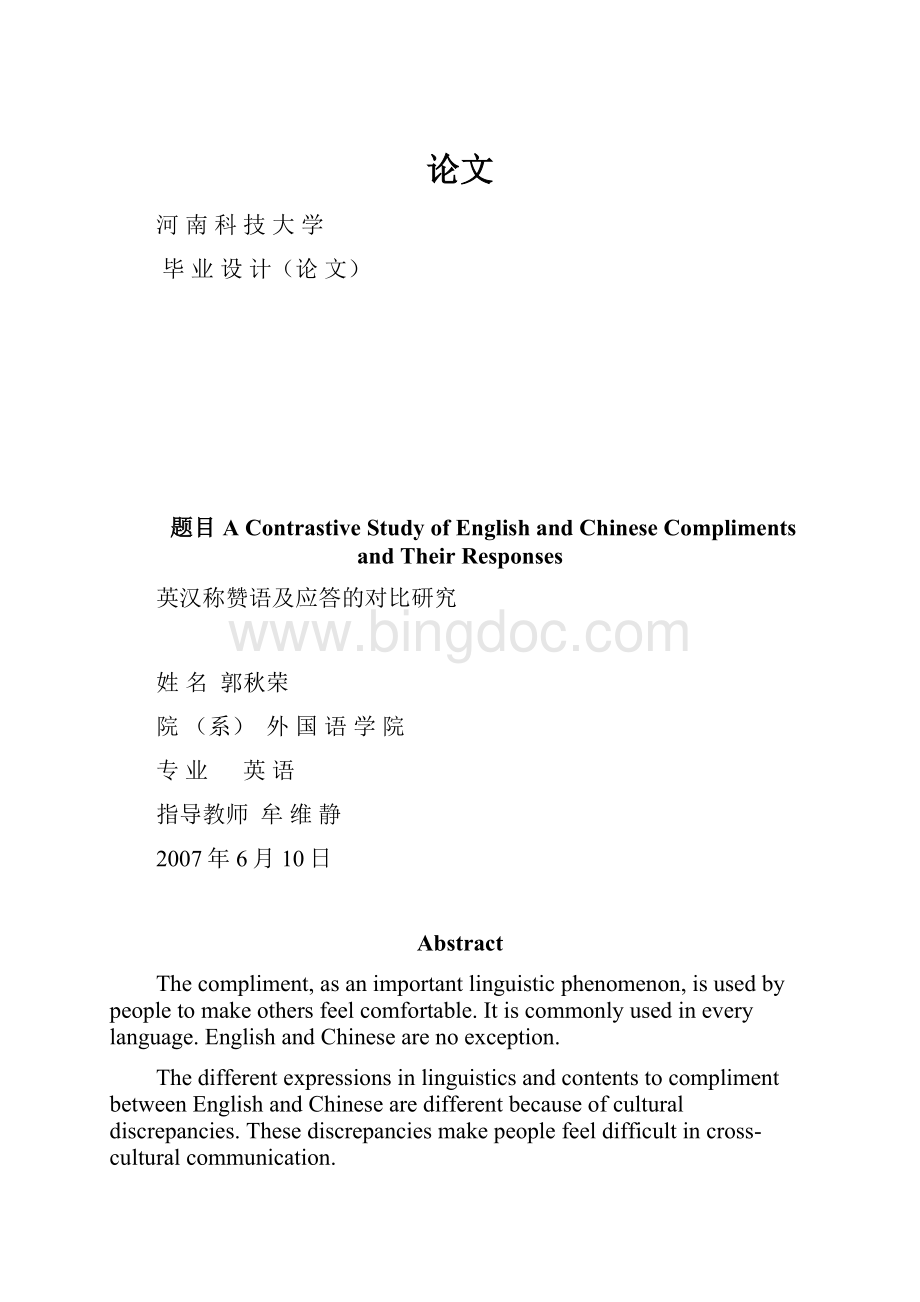论文.docx
《论文.docx》由会员分享,可在线阅读,更多相关《论文.docx(19页珍藏版)》请在冰点文库上搜索。

论文
河南科技大学
毕业设计(论文)
题目AContrastiveStudyofEnglishandChineseComplimentsandTheirResponses
英汉称赞语及应答的对比研究
姓名郭秋荣
院(系)外国语学院
专业 英语
指导教师牟维静
2007年6月10日
Abstract
Thecompliment,asanimportantlinguisticphenomenon,isusedbypeopletomakeothersfeelcomfortable.Itiscommonlyusedineverylanguage.EnglishandChinesearenoexception.
ThedifferentexpressionsinlinguisticsandcontentstocomplimentbetweenEnglishandChinesearedifferentbecauseofculturaldiscrepancies.Thesediscrepanciesmakepeoplefeeldifficultincross-culturalcommunication.
Basedonthemethodofcomparativeanalysisinlinguistics,thispaperistodoalinguisticstudyoncomplimentarybehaviorbetweenEnglishandChineseinordertomakecommunicationmuchsmooth.Thispaperconcentratesonthecontrastofexpressionsinlinguistics,contentsandcomplimentresponses:
suchasdifferencesatthesemanticandsyntacticallevels,differencesincomplimentingappearances,newandoldacquisitionsandgoodworketc.Thepaperistodiscover,inessence,theculturalelementsthatgovernthedifferencesbetweentwokindsofcompliments.Thiscomparativestudymustbehelpfultopeopleincross-culturalcommunication.
KEYWORDS:
compliments,complimentresponses,culturalelements
摘要
称赞语作为一种重要的语言现象,常被人们用来称赞对方,目的是使对方产生良好的感受。
它在每种语言中都有广泛的使用。
英语和汉语中也不例外。
由于文化差异,导致英汉称赞语在语言表达方式和称赞内容上存在不同。
这些不同使人们在跨文化交际中感到很困难。
为了促进交流的顺利进行,本文按照语言学中对比分析的方法,针对英汉两种称赞言语行为进行对比研究。
主要内容包括:
语言表达方式上的对比,称赞内容上的对比,称赞回应上的对比。
比如文章将比较称赞语在词法和句法上的差异以及在称赞外表,称赞新旧事物,称赞工作上的差异等等。
文章还将从本质上揭示造成英汉称赞语差异的文化根源。
这种比较研究,必将有助于英汉跨文化交际的顺利进行。
关键词:
称赞语,称赞语应答,文化因素
Contents
Acknowledgements
AbstractinChinese
AbstractinEnglish
1.Introduction………………………………………………………………………………..
2.Contrastoflinguistics………………………………………………………………………
2.1Contrastoflinguisticsatthesemanticlevel…………………………………………
2.2Contrastoflinguisticsatthesyntacticallevel………………………………….
3.Contrastofcomplimentarycontents…………………………………..
2.1Oncomplimentingpersonalappearance………………………………………
2.2Oncomplimentingtheacquisitions…………………………………………………..
2.3Oncomplimentingthegoodwork…………………………………………………
2.4Othercomplimentarycontents……………………………………………………
4.Contrastofcomplimentresponses……………………………………..
3.1OnEnglishcomplimentresponses…………………………………………………..
3.2OnChinesecomplimentresponses…………………………………………………
3.3AnalysisofEnglishandChinesecomplimentresponses……………………………..
5.Influenceofculturalelementsoncompliments……………………………..
4.1Conceptionsofindividualismandcollectivism……………………………………..
4.2Conceptionsofequalityandhierarchy……………………………………………….
4.3Otherculturalelements……………………………………………………………
6.Conclusion…………………………………………………………
Bibliography…………………………………………………………..
1.Introduction
Acomplimentisaspeechactwhichexplicitlyorimplicitlyattributescredittosomeoneotherthanthespeaker,usuallythepersonaddressed,forsome‘good’possession,skill,etc.,whichispositivelyvaluedbythespeakerandtherheare.Itisarguedthatthecomplimentisasocialmeansbywhichpeopletaketheadvantageofthepreferringwordsofpraisetomaintainandpromotetheinter-personalrelationships.Thereisnodoubtthatforpeoplepayingappropriatecompliments,identifyingthemaccurately,andmakingproperresponsesareimportantaspectsofcommunicativecompetence.Buttheseaspectsdifferinavarietyofwaysfromoneculturetoanother.Soitisnecessaryforustodiscoverthesimilaritiesanddifferencesincomplimentsindifferentculturestomakecommunicationmuchsmooth.Meanwhile,ithasbeendemonstratedagainandagainthatbeneaththeexpressionsofthelinguisticformsandthesocialetiquetteinvolvedintheiruseliesagold-mineofinformationaboutthevaluesystemsofthespeakers.Thesocialnormsinvolvedmaygovernspecificspeechactsorspeechbehavioringeneral.Soinordertoresearchintocomplimentsdeeplyanddiscoverthegeneralcultureelementsandnormsexpressed,themethodoflinguisticcontrastisusedinanalyzingEnglishandChinesecompliments.Firstlytheauthoristocomparethedifferencesandsimilaritiesofcomplimentsandtheirresponsesonwaysoflinguistics,contentsandresponsestocompliments,thentodiscoverthebasicculturalfactorswhichleadtothedifferentiationsoftwocompliments.
2.Contrastoflinguistics
Judgingfromthelinguistics,thefixedregulationsdefinitelyexist.Buttherearenotabledifferences.Theauthoristoanalyzefromthesemanticandsyntacticalleveltofindoutthesimilaritiesanddifferences.
2.1Contrastoflinguisticsatthesemanticlevel
Generallyspeaking,thepositivewordsarefrequentlyusedinEnglishandChinesecompliments.Buttherearedistinctdifferencesinchoosingpositiveadjectives,adverbsandverbsintwolanguages.
2.1.1SemanticfeaturesofEnglishcompliment
InEnglish,themajorityofwordsinwhichthepositivesemanticevaluationiscarriedareadjectives.What’smore,manyofadjectivalcomplimentsmakeuseofonlyfivedifferentadjectives:
nice,good,beautiful,prettyandgreat,withalltherestoccurringonlyonceortwice.Ifweconsidertheextremelywideprivilegesofoccurrenceofthesefiveadjectives(asopposedtosuchnarrowlyapplicableadjectiveasdelicious),itisnotsurprisingthattheyshouldprovetooccursofrequently.Indeed,thevagueandgeneralthattheyareequallyappropriatewhenreferringtosuchdiversesubjectsashair,e.g.“That’sagoodhairstyle”,clothing,e.g.“Thatshirtlooksnice”,ability,e.g.“Sheisagoodactress”,oraccomplishment,e.g.“Yourlecturewasgood”.
Ofcomplimentswhichmakeuseofverbstocarrythepositivesemanticevaluation,theoverwhelmingmajoritieshaveeither“like”or“love”andthosetwoverbscanbeappliedtovirtuallyanytopicfromsports,icecream,clothing,jewelryandpeople,e.g.“Ilike/loveyourearring”.Again,themoregeneralthemeaning(ortheweakerthesemanticload),thegreaterthefrequencyofoccurrence,alotofallcomplimentsinconversationwhichrelyonaverbfortheirpositiveevaluationmakeuseofeither“like”or“love”.
Althoughnearlyallwordsconsistofcomplimentswithsemanticallypositiveadjectivesandverbs,afewdorelyonanadverb,usuallywelltoexpressthepositiveevaluation,e.g.“Youdothiskindofwritingsowell”.Andanadditionalfewdependonanoun,e.g.“You’rejustawhizatsewing”.
It’sclearthatinEnglishcontext,speakersstronglyprefertochoosefromoneofonlyfiveadjectivesandtwoverbstoexpresstheirfavorableevaluationofothers.
2.1.2SemanticfeaturesofChinesecompliment
InChinese,however,positivewordsexpressingcomplimentsaremainlyadjectives,adverbsandverbs,e.g.“Youarereallyanexperiencedteacher”,“Yourroomisreallyneatandclean”,“Youdidthehomeworkverywell”,“Youstudyhardandmakeprogressveryrapidly”,“Youtreatpeoplesincerely”,“Iespeciallylikethecolorofyourskirt”,“Youdeservedhonor”.
Byanalyzingtheseexamples,itcanbegeneralizedthatmostoftheChinesecomplimentsmakeuseofadjectivesandadverbs,andonlyalittletakeverbsaswordsexpressingcompliments.Moreover,thefrequentuseofadverbsisshownnotonlybynearlyhalfofthecomplimentswhichhaveadverbsaspositivesemanticloadcarrier,butalsobythefactthatmostofthepositiveadjectivesandverbshaveadverbsastheirintensifierssuchaszhen(“really”,“truly”or“indeed”),andtai(“very”,“verymuch”or“excessively”),ThisfacthasformedacharacteristicoftheChinesecompliments.
2.1.3Resultofcontrast
Afterthesemanticfeaturesintwolanguageshavebeenanalyzed,theregulationscanbegeneralizedasfollows:
1.TheadjectivesandverbsarefrequentlyusedinEnglishcompliment,comparedwiththeadjectivesandadverbswhicharecommonlyusedinChinesecompliment.
2.Mostofthecommonlyusedwordsarepositiveones.
2.2Contrastoflinguisticsatthesyntacticallevel
Similarly,complimentsintwolanguagesarequitedifferentatthesyntacticallevel.Theauthoristoanalyzethecomplimentsbygivingexamplestoillustratethedifferencesinsyntaxintwolanguages.
2.2.1SyntacticalfeaturesofEnglishcompliment
Similarly,theexpressionsoftwokindsofcomplimentscarrythedifferentfeaturesinlinguistics.
Englishcomplimentstructureisevenmoreseverelyrestrictedonthesyntacticlevelthanonthesemanticlevel.53.6%ofallthecomplimentsinthecorpusmakeuseofonesinglesyntacticalpattern:
①NPis/looks(really)ADJ(e.g.Thisroomlookssocomfortable.)
Twoothersyntacticpatterns:
②I(really)like/loveNP(e.g.Ilikeyourdress.)
③PROis(really)(a)ADJNP(e.g.Thiswasreallyagreatmeal.)
Thesetwoaccountforanadditional16.1%and14.9%ofthedatarespectively.Whatthismeansisthat85%ofthecomplimentscollectedcanbedescribedbyonlythreesyntacticpatterns.Withrespecttotheother15%ofthecorpus,onlysixotherpatternsoccurwithanyregularity,andthemostfrequentoftheseappearsinonlyalittlemorethan3%ofthedata.Nootherpatternsbesidesthesenineoccurmorethantwice.Theothersixpatternsare:
④YouV(a)(really)ADJNP(e.g.Youdidagoodjob.)
⑤YouV(NP)(really)ADV(e.g.Youreallyhandledthesituationwell.)
⑥Youhave(a)(really)ADJNP(e.g.Youhavesuchbeautifulhair.)
⑦What(a)ADJNP(e.g.Whatalovelybabyyouhave.)
⑧ADJNP(e.g.Nicework!
)
⑨Isn’tNPADJ(e.g.Isn’tyourringbeautiful?
)
2.2.2SyntacticalfeaturesofChinesecompliment
WhileinChinese,themostfrequentlyusedsyntacticalpatternsaresummedupas:
①YouVADV(e.g.Yousingwell!
).
Anotherfrequentlyusedpatternis:
②(Your)NP(or“ofyours”)isADV(intensifier)ADJ
(e.g.Yo